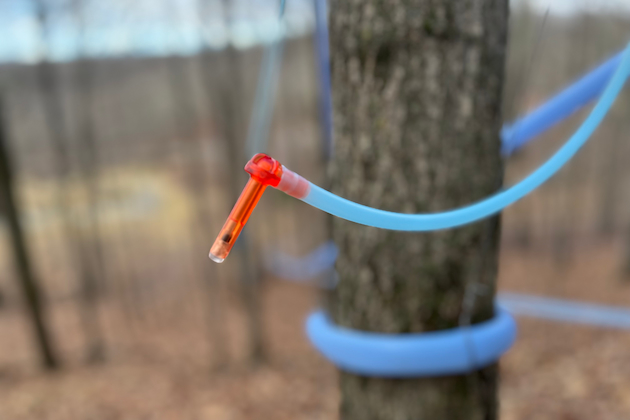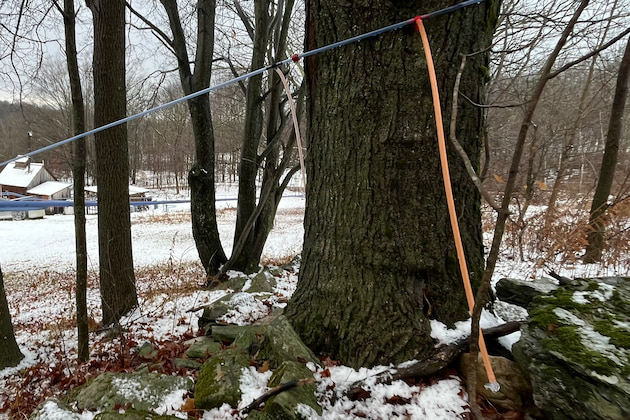UVM Proctor Page
Spout deployment: Late fall, early winter, late winter?
Proctor Center says it makes no difference
By BY TIMOTHY D. PERKINS AND WADE T. BOSLEY | DECEMBER 20, 2023
UNDERHILL CENTER, Vt.—The influence of spout and dropline sanitation practices on sap yield has been widely studied over the past 15 yrs.
There are a wide variety of methods to achieving good sanitation in tubing systems.
The choice of which approach to utilize largely comes down to producer goals, economics, and personal choice.
In the United States, sanitation is largely achieved through the annual replacement of spouts (with regular or check-valve spouts).
This replacement approach is also employed by some producers in Canada, but is less common due to the widespread use of isopropyl alcohol, which is not permitted as a sanitizing agent in maple tubing systems in the U.S.
What is less well understood is the effect that other associated practices sometimes employed in the replacement strategy has on sap yield.
At the Proctor Center, researchers demonstrated that sap production is not significantly different when new spouts are deployed in the field in the late-fall preceding sugaring season, in January before the season, or during tapping time.
It seems that as long as the weather is cold (mostly subfreezing), deployment of spouts into the woods and subsequent exposure to the elements doesn’t negatively impact yield.
However, there are other tubing management practices for which little is known about how they affect sap yield.
One in particular that is debated by producers who use replacement strategies is whether to plug drops when spouts are pulled or to let them dangle open to the air to dry (unplugged).
Because of the lack of knowledge on this topic and the frequent questions we received about the proper practice, we implemented a study in the summer of 2022 to examine the single and interactive effect of spout deployment date and open verses closed drops on sap yield.
Immediately following the 2022 sap flow season at the University of Vermont Proctor Maple Research Center in Underhill, Vermont, all spouts (approximately 1,285 trees) were removed from the taphole and cut off the drop.
Drops on 8 research mainlines were left unplugged and dangling to drain whereas drops on another 8 other research mainlines were plugged onto the tee.
In October, clear polycarbonate Lapierre spouts were installed on all drops on 4 of the unplugged mainlines and also on all drops on the 4 plugged mainlines.
In mid-February 2023, spouts were installed on the remaining 4 mainlines with plugged and 4 mainlines with open (unplugged) droplines and trees on all mainlines were tapped.
Drops for all treatments were 3 yrs old and had not been chemically cleaned.
Sap from each mainline flowed to an individual mini-releaser equipped with a counter. Each dump of the releaser incremented the counter.
Counts were recorded for each day of flow and multiplied by the calibrated amount of sap released in each dump.
This total was then divided by the number of taps per mainline to calculate the total yield (gallons of sap) per tap for each mainline, then averaged for each of the treatments.
Unsurprisingly, results for spout deployment month were similar to those found in our previous study (Perkins, van den Berg, and Bosley 2021).
There was no significant difference in sap yield for spouts deployed in October versus those deployed during tapping in February.
Similarly, leaving drops open and dangling or plugged onto tees had no significant effect on sap yield.
It is worth noting that this study ran for only a single season and thus should be repeated to ensure the results are valid under a variety of conditions, however, these results suggest that producers can follow whichever approach seems to fit best in their operation.
In examining the individual treatments, spouts deployed in October, especially onto drops that had been plugged tended to slightly (but not significantly) underperform the other treatments.
This is likely due to the fact that October 2022 was unseasonably warm. Therefore, there may have been a small amount of microbial activity that lightly contaminated spouts in that treatment before the weather turned colder, resulting in slightly reduced sap yield.
The results also suggest that if producers wish to deploy spouts slightly prior to sub-freezing weather, leaving drops open may be the better choice in terms of sap flow during the subsequent season.
Literature Cited
Perkins, T.D., A.K. van den Berg, and S.L. Childs. 2019. A Decade of Spout and Tubing Sanitation Research Summarized. Maple Digest 58(3): 8-15.
Perkins, T.D., A.K. van den Berg, and W.T. Bosley. 2021. Timing of Spout and Dropline Deployment Has No Effect on Sap Yield. Maple Digest 60(3): 9-12.

































